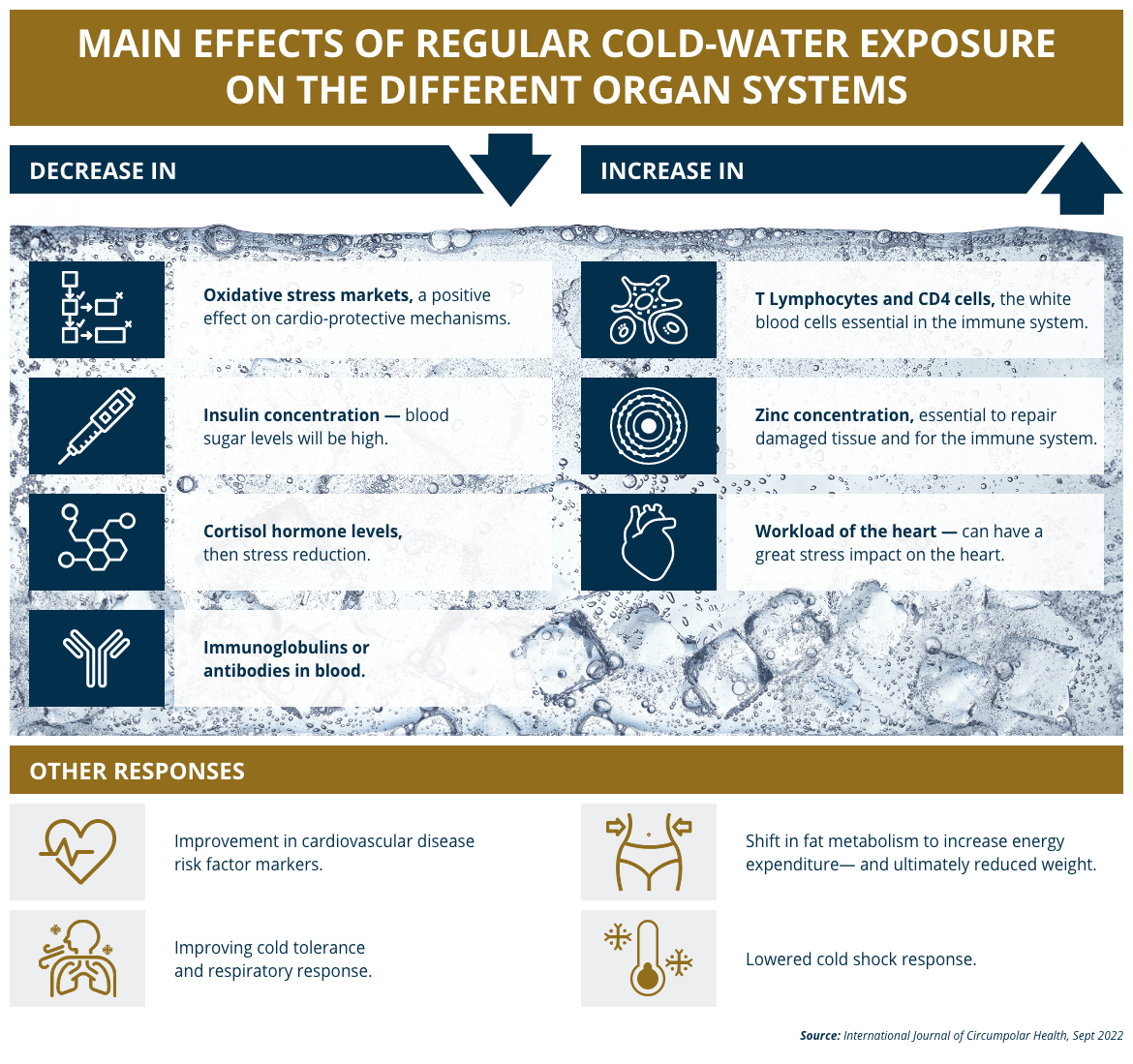Español
United States
Complementary and Alternative Medicine
Cold Water Therapy: Benefits and Risks of Ice Baths
August 16, 2024
Estimated Reading Time: 4m

123 RF
It’s a common practice for populations living in arctic regions: Submerging the body in a tub of cold water for a few seconds or going for a swim in an icy lake. However, science shows that this cultural tradition can be more than a hobby and can have tangible health benefits — though these can vary for each individual.
Cold therapy or cold water immersion, also known as cryotherapy, uses exposure to cold temperatures to cool down the body tissues for therapeutic purposes. This can be done in several ways:
- Cold showers, where the water temperature is set to 15 degrees Celsius (60 degrees Fahrenheit) or lower for two or three minutes, alternating hot and cold water for the same amount of time.
- Full body immersion (except for head and neck) in a tub of cold water or water and ice.
- Use of ice on certain areas of the body to treat specific muscle injuries.
- Use of cold sprays or vapors, known as whole‑body cryotherapy.
What the Science Says
For many, the trendy idea that cold temperatures can help preserve our youth is just a myth. But some scientific studies suggest that the therapeutic use of ice water on a regular basis may be effective in treating chronic autoimmune inflammation and reducing hypercholesterolemia. In addition, cold therapy could have a positive impact on stress and on blood circulation.
As this research points out, cold water is not a miracle worker; this therapy works best when combined with other lifestyle habits. Stress management techniques, a healthy diet, and social interactions all play a role in keeping our minds and bodies balanced.
Cold water shock also seems to have an impact on the brain. In one investigation, researchers carried out CT scans of people following a 5‑minute cold water immersion session in order to observe changes in the so‑called positive and negative affect. They observed that short‑term immersion in cold water was associated with facilitating positive affect — people felt more active, alert, attentive, proud, and inspired — and reducing negative affect — people experienced reductions in distress and nervousness.
Scientists are studying the effect of cold water therapy as a therapeutic strategy for the treatment of obesity and type 2 diabetes.
Research shows that cold water immersion can be beneficial to athletes performing high‑impact exercise. A review of 52 studies concluded that this therapy was an effective tool for recovery after high‑intensity exercise, with positive results for muscle potential.

Is Cold Therapy Dangerous?
Experts warn that you should always check with your doctor before trying out cold therapy, since — like other natural treatments and remedies — this one is not recommended for everyone. Elderly people should not pursue cold therapy; the same goes for individuals who suffer from heart disease, as the shock of initial contact with ice water increases stress on the heart and can put them at risk of heart attack and arrhythmias.
The effects of cold water therapy can vary greatly from person to person. Some may find it helpful, while others may experience adverse effects or feel uncomfortable.
Here are some of the most common hazards:
- Prolonged exposure to cold water can lead to hypothermia, a potentially dangerous condition in which the body loses heat faster than it can produce it. Hypothermia can be life‑threatening and requires immediate medical attention.
- Exposing the skin or extremities to extremely cold water for a prolonged period can lead to frostbite. This condition occurs when skin and underlying tissues freeze, which can lead to severe tissue damage.
- Sudden exposure to cold water can trigger a cold‑shock response, causing shortness of breath and an increased heart rate. This can be particularly risky for people with heart problems.
Those who have secured the approval of their doctors and want to give cold therapy a try, keep these recommendations in mind:
- If you plan to swim in an icy lake or other body of water, make sure it’s safe, and don’t go alone.
- Exposure to extremely cold water should always be brief. Stop before you feel numbness, chills, or pain.
- Be prepared for when you get out of the cold: have a towel, dry clothes, a warm environment, and a hot chocolate or drink ready. Note that your muscles, hands, and feet may feel numb.
- Driving as soon as you get out of the water is not recommended.
In general, while ice baths and cold therapy may have some benefits, it’s essential to approach them with caution and be aware of potential risks.
Remember, always consult with your physician or health care professional to determine the best options for your body and health and to answer any questions you may have regarding any medical matter.
To learn more about solutions available to you,
NAHGA Claim Services Data Breach Information
